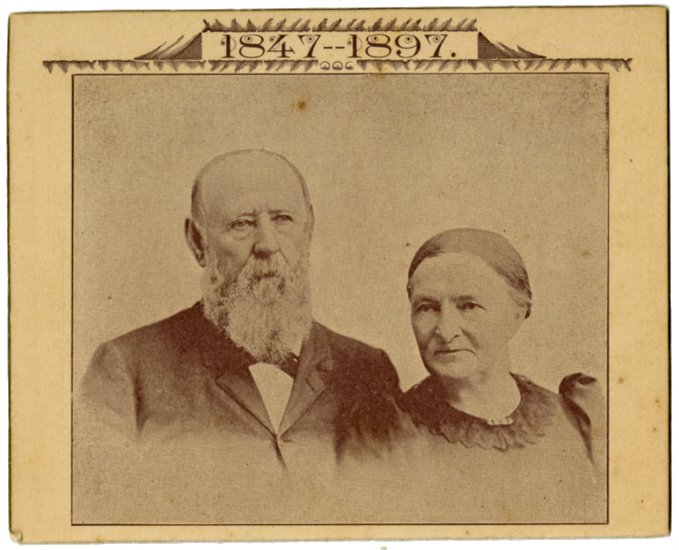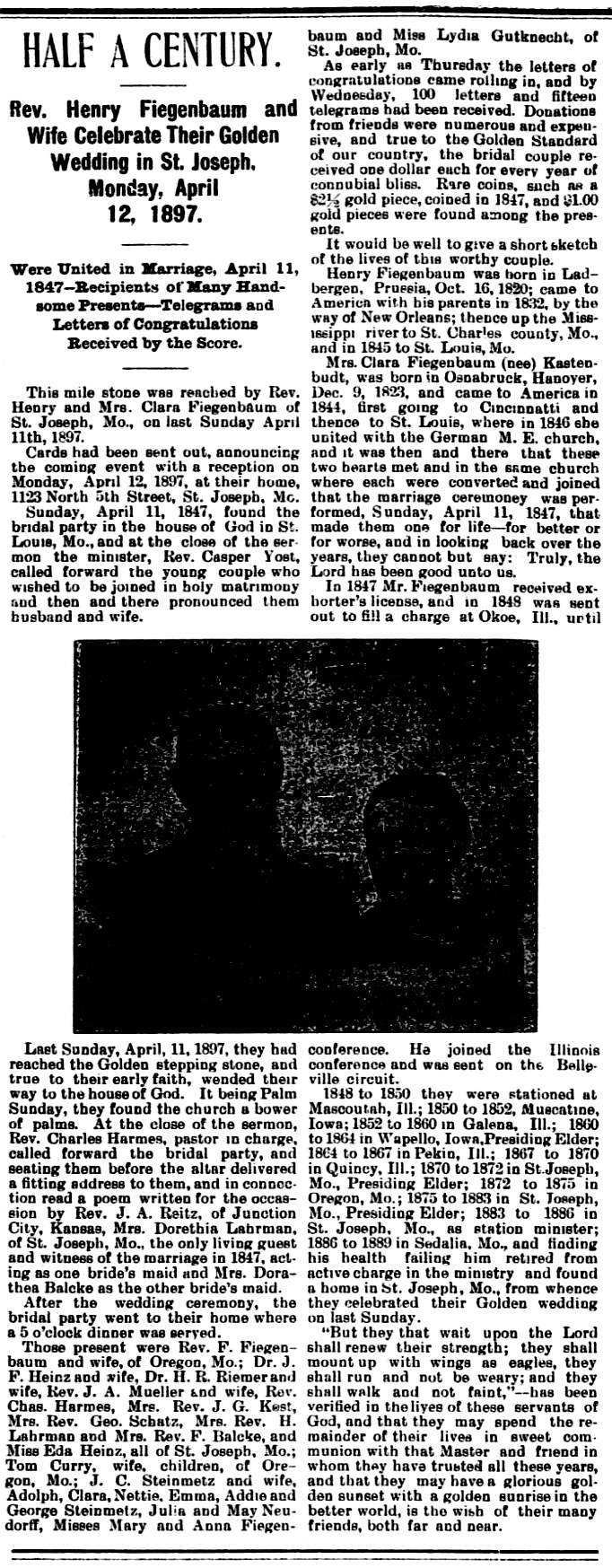On This Page
Rev. Heinrich Hermann Fiegenbaum
and
Clara Catherine Kastenbudt
Golden Wedding Anniversary

Fiftieth Wedding Anniversary Card

Source: "Half a Century," in The Holt County Sentinel (Oregon, Missouri); Friday, 16 April 1897; page 4, columns 3-4.
Digital copies accessed through Chronicling America: Historic American Newspapers (The Library of Congress) in November 2011.
Notes on this Newspaper Article
The Photograph
The image available with this digital copy of the newspaper article is of very poor quality, but it is possible to recognize it as the photo used on the anniversary card shown at the top this web page. A digital copy of the studio portrait has been very generously provided by W. Richard Nelson, Jr. and is available on this site in our collection of photos.
The Wedding
Rev. Casper Jost (as his name appears in all of the church documents I have consulted) emigrated from Germany in 1840 and settled first in Cole County, Missouri. He was received into the Missouri Conference in 1844; the South St. Louis mission was his first appointment. In September 1845 at the annual church conference at Springfield, Illinois, he was ordained a deacon and appointed to the North St. Louis station. He was ordained an elder in September 1846 and continued his work in St. Louis.
In September 1847, a few months after marrying Heinrich Hermann Fiegenbaum & Clara Catherine Kastenbudt in St. Louis, Pastor Jost was appointed to the Milwaukee mission.
The Guests
I am able to identify some of the guests of the anniversary celebration who are mentioned by name in this article:
Rev. F. Fiegenbaum and wife, of Oregon, Mo.
This is Henry Fiegenbaum's younger brother, Friedrich Wilhelm Fiegenbaum, and his wife, Louisa Otto. Friedrich Wilhelm was a pastor in the German Methodist Episcopal Church, as were all three of Henry's brothers. He had served the local congregation at Oregon, Holt County, Missouri, from 1892-1896 and continued living there in his retirement until about 1902, at which time he and Louisa moved to Wathena, Doniphan County, Kansas.
Tom Curry, wife, children, of Oregon, Mo.
Christina Wilhelmine "Mina" Fiegenbaum, Henry and Clara's sixth child, was married to Thomas Curry, part owner of The Holt County Sentinel. They lived in Oregon, Missouri with their two children, William R. Curry and Anna Helen Curry.
J. C. Steinmetz and wife, Adolph, Clara, Nettie, Emma, Addie and George Steinmetz
Henry and Clara's third child, Caroline Katherine "Carrie" Fiegenbaum, was married to Johann Carl Conrad Steinmetz. Their children were: Adolph H., Clara Gertrude, Annette "Nettie" W., Emma Theodora, Adelia "Addie" Lasette, and George Harold. The family lived in St. Joseph, Buchanan County, Missouri.
Julia and May Neudorff
Lizette Clara Fiegenbaum, Henry and Clara's seventh child, had married Frederick Franklin Neudorff in 1881 at St. Joseph, Missouri, where Frederick was involved in retail merchandising, especially hardware. They had three children: Julia W., Franklin Grant, and Clara May.
Lizette (or Lisette, as she is sometimes identified) died on 6 February 1892 at the age of 29 years. Her son, Franklin, died on the 22nd of the same month.
Frederick Neudorff remarried in 1893, to Mary Bauer; they were the parents of four children. These six members of the family are not mentioned as guests at the anniversary celebration.
Misses Mary and Anna Fiegenbaum
These were daughters of Henry and Clara. Anna Maria Fiegenbaum, known as Mary, was blind from about the age of 10. Anna Julia, called Anna, worked as a sales person in St. Joseph department stores. Neither woman married; they lived with their parents, and then later lived together. Judging by mentions in The Holt County Sentinel, Mary does not seem to have gotten out much, but Anna often attended social gatherings and church affairs in Oregon, Missouri and elsewhere in the state. In 1901, she spent the summer traveling out west – in California and Oregon.
Heinrich's Birth
Family members who live in Germany and who have examined the archives of the evangelical churches of northwestern Germany report that Heinrich Hermann Fiegenbaum was born on 15 October 1821 (not 1820) in Lengerich, Province of Westphalia, Kingdom of Prussia.
Heinrich's father, Adolph Heinrich Fiegenbaum, was born and raised in Ladbergen, but moved to nearby Lengerich, the home town of his wife, Christine Elisabeth Peterjohann, after their marriage in October 1820. Their first five children were born in that community. The sixth and last child, Heinrich Rudolph, was born after the family emigrated to Missouri.
Migration to the U.S.A.
The story of the Fiegenbaum-Peterjohann family's immigration to Missouri is complicated and is discussed in full in the Migration section of this web site.
Here it is sufficient to say that I believe the parents and five children, ages about 12 years to about 1 year, arrived at New Orleans, Louisiana in late June 1834 and traveled up the Mississippi River, reaching St. Louis, Missouri in early July, perhaps about the 3rd or 4th, as Friedrich Wilhelm Fiegenbaum recalled.
The family appears to have settled initially in Femme Osage Township, St. Charles County, Missouri. Within a few years they moved to nearby Warren County, Missouri, not far from where Adolph's brother and his family settled upon arriving in the state in 1841.
By the middle of 1850, four of the children had married and set off on their own. Adolph, Christine and their two youngest sons, still living at home, relocated to a farm near Wapello, Louisa County, Iowa.
Service in the German Methodist Episcopal Church
The service of this branch of the Fiegenbaum family in the German M. E. Church is another complicated story. To do it justice would require an essay devoted to that topic alone; it is yet to be written. In the meantime, you will have to do some of the heavy lifting yourself and piece together the story from the scraps I have managed to gather.
Heinrich Hermann Fiegenbaum and his three brothers were all pastors in the German Methodist Episcopal Church. His two sisters were married to pastors in the same denomination. It was the practice of the Church to move its ministers to new appointments frequently; often every two to three years at the start of their careers, less often later in life.
During this era of the Church's history, it was not uncommon for an appointment to include a circuit of charges composed of a number of separate congregations, each of which might be in a different stage of development and also some distance from one another. The figure of the circuit pastor (in German, Reiseprediger), on foot or horseback, braving all manner of weather and away from home for extended periods, is a icon of Methodist Church history, even if he is not unique to that tradition or time period.
The role of itinerant ministers in the family's early life in Missouri and in their introduction to Methodism is described in an essay written by Henry's brother, Hermann Wilhelm Fiegenbaum, in an autobiographical sketch written by his sister, Marie Wilhelmine (Fiegenbaum) Winter, and in an article about these Fiegenbaums, published in the St. Louis Post Dispatch in 1898. Henry's brother, Friedrich Wilhelm Fiegenbaum, paints a vivid picture of his own life as a pioneering pastor in the autobiographical letter he composed for his children.
As the western frontier of the nation became more settled throughout the 19th century, the Methodist Church found it necessary from time to time to reorganize itself, creating new conferences and districts. Pastors who might be engaged in the same work as before could suddenly find themselves with a new affiliation. Or, they could find themselves transferred to a new section of the country. For the modern researcher, church records of the individual you are studying now reside in a different repository or have been published by different agencies.
On top of all of that, I suspect that at least one of the Fiegenbaum brothers had his own wanderlust that was quite unconnected to any calling or career that he might have chosen.
Successfully following the movements of Adolph and Christine's children through this personal and bureaucratic flux requires some concentration and a fair bit of luck. I am not confident that the picture of their adult lives that I have assembled to date is complete or accurate. You can find these developing stories briefly outlined in any of the More Resources documents listed below which mention a chronology.
Henry's Appointments
The true identity and location of Okoe, Illinois, mentioned as Henry's first charge, remains a mystery to me. I have not yet been able to find any city, town, township or village with this name.
The rest of the locations are mentioned in the biographical material and chronology for Henry.